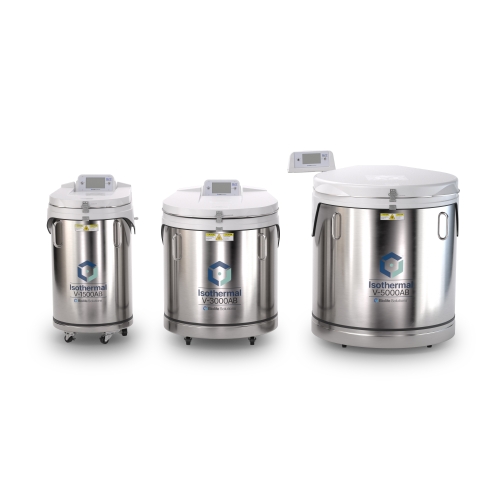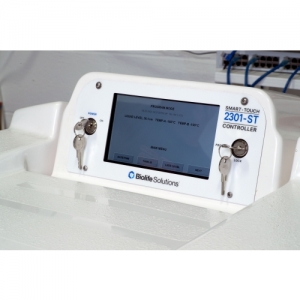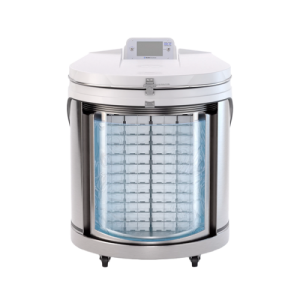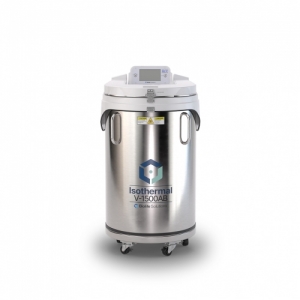
V系列液氮凍存系統不同於"S"系列之處是凍存的樣品不直接浸入液氮之中,而樣品的凍存溫度能維持在-195℃左右
特點
- 由於凍存腔中無液氮,樣品之間交叉污染可能性降低,同時,使用者也避免了被液氮凍傷,增加了安全性。
- 凍存腔內溫度範圍為-188℃~195℃,內溫度差降至最小,達到最穩定的凍存狀態。
- 節省液氮,液氮儲存在夾層中,蒸發量降低。
- 4種規格液氮凍存桶,儲存樣品容量為9100~46500支 2ml試管。
- 圓形省空間設計,底部安裝滑輪不銹鋼桶體,環型充氮管路及探頭管;可鎖式頂蓋,內配絕熱密封蓋墊。
- 多種樣品凍存架、試管凍存盒、血袋保存盒可供選擇,還可按客戶要求訂制。
- 與低壓液氮供應桶(22磅)搭配使用。
- 大螢幕液晶顯示器,具雙溫度顯示、液態氮充填狀態、高低液面限制、系統狀態、充氮/啟動或停止、紀錄顯示等功能。
- 具有聲光警報(含遠端報警),高低液面、溫度警報、溫度探頭及液氮供應、液氮氣體、充氮閥、排氣探頭。
- 斷電警報、遠端警報(需加配裝置)
- 具有0-5V及4-20mA之溫度與液面參數輸出訊號端子。
-
可連續充填功能,可選擇單次充填或全部充填。
具有LN2供應桶自動切換之輸出信號,可連接附件TS-1B裝置(Tank Switcher),以連Tank2或Tank3。
規格表:
|
型號 |
液態氮容量(L) |
外部尺寸(W×D×H / mm) |
內部尺寸(Φ×H / mm) |
|
V-1500AB |
30 |
675.6×1005.8×1211.6 |
533.4×736.6 |
|
V-3000AB |
70 |
955×1277.6×1249.7 |
787.4×736.6 |
|
V-3000EH-AB |
89 |
955×1277.6×1463 |
787.4×939.8 |
|
V-5000-AB |
93 |
1371.6×1450.3×1430 |
1016×736.6 |
|
V-5000EH-AB |
140 |
1371.6×1450.3×1551.9 |
1016×863.6 |
介紹影片:
目錄下載
Custom Biogenic Systems Isothermal LN2 Freezers
Isothermal LN2 freezers from Custom Biogenics offer cryogenic dry storage for medical laboratories, universities and research facilities while reducing the risk of cross-contamination. Our patented technology creates a jacketed space in the walls of the freezer, maximizing storage space inside and minimizing the chances of cross-contamination. The wide lid makes it easy to access samples without affecting the temperature inside the freezer.
Cryogenic dry storage eliminates many of the risks associated with liquid nitrogen contact. User safety is of paramount importance in any laboratory setting, and dry storage is less risky for the user than coming into contact with liquid nitrogen. Cryogenic storage methods that rely on contact also subject the vials to shrinking and expansion, which lead to sudden explosion. Dry storage allows for consistent temperatures and more stable storage. All of our vapor storage freezers accommodate standard rack systems and adhere to industry best practices for temperature uniformity.
Custom BioGenic Systems Isothermal Liquid Nitrogen Freezers offer liquid nitrogen storage temperatures without liquid nitrogen contact. Liquid nitrogen is stored in our patented jacketed space in the wall of the freezer. This technology offers safe dry storage for your samples. With no liquid nitrogen in the storage area the risk of cross contamination and the safety risks associated with the handling of liquid nitrogen are greatly reduced. This also means that the entire storage space can be used for inventory. Our wide lid opening provides easy, unrestricted access to samples and won’t affect the temperature inside the freezer. All Isothermal freezers use our time tested and reliable 2301 controller with a dual temperature display, autofill and many additional features. Custom BioGenic Isothermal Liquid Nitrogen Freezers have an industry best temperature gradient that averages -193°C inside the storage area.All Online Prices of freezers are for US sales only. International purchases must go through our distributors.
Why is dry storage important?
- Dry storage greatly reduces the risk of cross contamination.
- Added user safety by eliminating liquid nitrogen contact.
- Utilize the entire storage space; no space lost to bulky platforms.
- Liquid nitrogen temperatures with no liquid nitrogen contact.
- Vapor circulation provides better visibility in the storage area.
- Wide lid opening for easy access to all racks.
- Accommodates all standard rack systems.
- Industry best temperature uniformity.
| Safety Storage in liquid nitrogen can make vials shrink. This may cause liquid nitrogen to seep into the vials, which on re-warming, expand and subsequently explode as nitrogen vaporizes inside the vials. Dry storage eliminates this possibility. Also, the Isothermal design provides added user safety by eliminating contact with or splashing of liquid nitrogen. |
||
| Cross Contamination Studies have shown that viral, bacterial and fungal pathogens can survive after suspension in liquid nitrogen. Infected samples can cross contaminate other samples in the same liquid nitrogen tank. Dry storage greatly reduces the possibility of cross contamination. |








